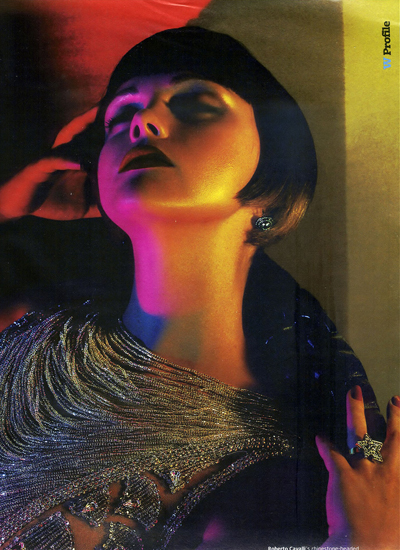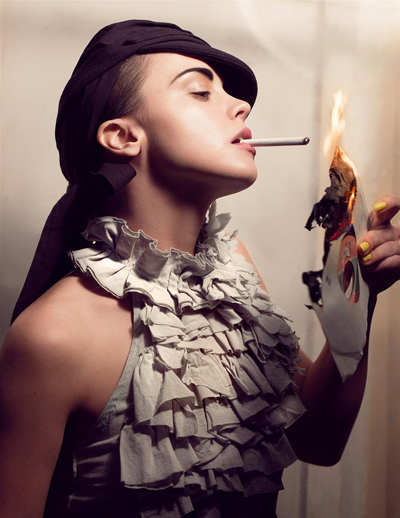
They say that you can never truly see yourself; not in mirrors, or photos, or windows, or water. All you see is a flat reflection. You go through life with only an idea of how other people see you in the three dimensions, always one step removed from every true angle. Unless you’re (un)-lucky enough to have a twin – “the creepy kind,” as one of my friends with a non-creepy, fraternal twin brother would put it. From mythical manifestations as partners-in-crime who finish each others’ sentences to polar opposites who seek to annihilate each other, the concept of twins has always enthralled and horrified the human race.

Photographer Janieta Eyre doesn’t have a twin sister, so she decided to make one for herself. Are the self-portraits a manifestation of her desire to see herself in more dimensions, act out a wish to have a twin or explore the creepiness of having one? Another interpretation is that the pictures are about choice, the aching wish that we all sometimes have to be able to make two choices simultaneously at one moment in time.
Posted by Nadya Lev on April 7th, 2008
Filed under Art, Photography | Comments (2)

Two images by photographer Janieta Eyre, featured at [FAT]
If you’re in Toronto, check out [FAT], or Toronto Alternative Arts & Fashion Week. The annual festival, which takes place from April 8 to April 11 this year, combines art, fashion, photography and performance. From their website:
Toronto Alternative Arts & Fashion Week is a multi-arts festival with a mandate of showcasing artistic disciplines rooted in fashion, and their exploration of the human body in today’s time. The festival aims to emphasize this mandate through the artistic disciplines of fashion design, photography, installation, video, performance, music and dance, in an effort to push forward and redefine our perception of the fashion phenomenon. When presented jointly, the underestimated social force of fashion is showcased, redefining its role in contemporary Canadian society as not only an economic colossus, but also as an engineer of social practices and vehicle for personal expression. The Toronto Alternative Arts & Fashion Week intends to introduce a broader audience to these related creative fields, building public interest while simultaneously creating a forum where artists can learn from and collaborated with each other.

Photographer Anna Ross and fashion label Plastik Wrap.
[FAT] Official Website
Posted by Nadya Lev on April 4th, 2008
Filed under Art, Events, Fashion, Photography | Comments Off on [FAT]: Toronto Alternative Arts and Fashion Week
When I first followed Beth’s suggestion and looked over Jeremy Harris’ website, my love of portraits naturally drew me to that section of his portfolio. The style there didn’t appeal to me at all – not stylized enough for my taste. But it turns out that’s precisely what makes his photos of asylums so spot on.

With so many photographers using lights and Photoshop to accentuate spookiness when capturing old hospitals and decaying buildings, Jeremy’s plain, day-lit images stand apart. There is a simple honestly that allows us to not dwell on various effects, however pretty they might be, but instead reveals the heart of these spaces. The result is more brutal and attractive than one might expect.

Posted by Zoetica Ebb on April 3rd, 2008
Filed under Art, Madness, Photography | Comments (12)

Venus Wept: “Justice is blind and, apparently, naked.”
Antiseptic is relatively new, and over the past year I’ve watched their designs get more and more complex. Their riveted leather corsets look aggressive by themselves, but when coupled with Venus Wept Photography’s hyper lighting, the augmented sharp edges and textures show you something even more dangerous and pleasurably painful-to-wear. A stylistic joyride that weaves through 80s dystopia chic, medieval armor, medical fan lacing and many other real and imaginary places from different times, the designs owe a debt to alt-fashion predecessors AMF and Mother of London, with Antiseptic’s designers on a fast track to a voice that’s completely their own.
The San Francisco-based duo behind Antiseptic doesn’t seem to be interested in commercial manufacture, and focuses on showing off their designs on runways and in elaborate fashion shoots. Most recently, they staged a fashion show the San Francisco Fetish Ball that brought together some of my favorite models for the first time.

Models, clockwise: Alex LaMarsh, Scar13, Eden and Kumi.
Posted by Nadya Lev on March 29th, 2008
Filed under End of the World, Fashion, Hair, Photography | Comments (9)

As a brief follow up to this recent post regarding Miss Jackson’s freakatude, let us ruminate on the April cover of BackBook magazine. Here she’s caged and dressed in latex by Polymorphe, House of Harlot, and Syren. Inside she’s snarling from behind some Very Serious headgear.

The BlackBook article describes this Matthew Rolston shoot and tells of “codpieces, feather ticklers, steel pelvic thrusters relieved of their phallic attachments, barbed cowhide whips are fanned out alongside some kind of automaton skull with a full set of human teeth and gums” here. Oh Janet.
Related articles on Coilhouse
Posted by Zoetica Ebb on March 27th, 2008
Filed under Fashion, Fetish, Photography, Uber | Comments (5)

Placid nuns with milky alien-beauty faces, glowing children with otherworldly skin conditions, and the most ordinary faces made strange by details such as a chalk-white complexion, a subtle change in proportions, overly-glassy eyes. These are the images of Russian artist Oleg Dou, who combines conventional photography with graphic rendering techniques to produce matching portraits of unsettling consistency.
Like many other good things, Oleg Dou’s art was introduced to me by Elegy Magazine. Elegy just released Issue 52, which features Alexander Hacke, Thurston Moore, Tim Burton/Johnny Depp, Nick Cave and Lisa Gerrard.

Posted by Nadya Lev on March 25th, 2008
Filed under Art, Magazines, Photography, Russia | Comments (7)

Peter Ashworth’s website just went through the first overhaul it’s had in years. It’s great to see the English photographer out and about, putting up new images on a site that looks like it’s easy to update. Above are two classic images that had a huge influence on me when I first began to do studio photography. The image of performer Lucifire with a gauze “veil” over her eyes pinned to her face by hypodermic needles will always remain, in my mind, one of the greatest fetish portraits ever taken. The image on the right, with its high contrast and clear space, was the first to show me a kind of abstracting isolation that I find crucial in producing a strong fetish image.
Below are two new works by Peter Ashwroth from a series called in excelsis. The models are Ulorin Vex and Viktorya, wearing the recognizable hairstyles of Robert Masciave. There’s a stark economy going on in his Ashworth’s older work with alt models that’s been replaced by high glam, and while I definitely enjoy these new images, I also hope to see more of the reductive, slightly-raw imagery that made such an impression on me in the past.

Posted by Nadya Lev on March 21st, 2008
Filed under Fetish, Hair, Photography | Comments (7)

“The gentleman who has the pleasure of tying the final bow owns you.”
– Mr. Pearl, interview
What strikes me about fetish legend/corsetier Mr. Pearl’s images is how much he looks like a true English gentleman – and how, magically, his 18-inch corseted waist works to enhance that image, the opposite of what one might expect it to do.
Mr. Pearl grew up in South Africa and moved to London at the earliest chance after completing his military service. He spent three years in New York in the early 90s, where he did his most intimate published interview, of which there are few. Already a renowned tightlacer by this time, Pearl treated corsetry with such reverence that he insisted on precision in every aspect of his involvement with it; when his New York interviewer described him as a corsetier, he interrupted. “Forgive me,” he said. “I am a designer who employs the corset and lacings into his designs. I am not a corsetier – I have not attained that specialized knowledge. There are only about five left in the whole world now, who possess that art. I hope one day to be amongst them.”
Fast-forward to the 2000s: Mr. Pearl is a successful corsetier, commissioned by Mugler, Lacroix, Galliano and Gaultier when they need a master to produce their corset designs for the runway. Clients include Dita, Kylie Minogue and Jerry Hall. He lives in Paris, and works out an atelier behind the Notre Dame.

Pearl & his creations. Corsets, BW: Michael James O’Brien, color: Francois Nars.
Despite his success, Pearl doesn’t have a flashy website. There’s no web store to offer plastic-boned corsets that bear only his name, no MySpace page and no blog. He’s known for his aversion to modern technology, and his only web interview was handwritten and transmitted by fax.
Posted by Nadya Lev on March 18th, 2008
Filed under Art, Britannia, Fashion, Fetish, Personal Style, Photography, Sexuality, Ye Olde | Comments (17)
Esteemed reader Tanya Vrodova says, “I love cabbage. I will do anything to spread the word about how awesome cabbage is.” To that end, she just introduced me to Chinese multidisciplinary artist Han Bing and his mischievous Walking the Cabbage (2000-2007) series.

Walking the Cabbage in the Subway Beijing, 2004 © Han Bing
Born in 1974 in an poverty-stricken village, Han Bing spent his childhood helping his parents farm the land and was the only student in his class afforded the chance to attend university. There he studied oil painting before moving on to less conventional mediums. His post-university work has focused on creating spontaneous, open-ended discourse that includes members of society who are often excluded or dismissed. He, like many other young Chinese artist, seems compelled to confront the dubious side effects of his nation’s obsession with urbanizing and modernizing at whatever cost.
From Bing’s website:
Walking the Cabbage (2000-2007) series of social intervention performance, video and photography works, Han Bing walks a Chinese cabbage on a leash in public places, inverting an ordinary practice to provoke debate and critical thinking. Walking the Cabbage is a playful twist on a serious subject—the way our everyday practices serve to constitute “normalcy” and our identities are often constituted by the act of claiming objects as our possessions. A quintessentially Chinese symbol of sustenance and comfort for poor Chinese turned upside down, Han Bing’s cabbage on a leash offers a visual interrogation of contemporary social values.

The Cabbage Walking Tribe in Harajuku I, Tokyo, Japan 2006 © Han Bing
Posted by Meredith Yayanos on March 14th, 2008
Filed under Art, Culture, Film, Food, Geekdom, Goth, Photography, Testing your faith | Comments (15)

Christina Ricci’s been an icon of dark beauty ever since the Adams Family movie. She’s played quirky and odd her entire life, her doll-like face and dark hair the epitome of spooky charm. Despite widely publicized body issues of her past and being just over five feet tall, Christina is a wonderful and versatile model.

She seems to have finally gotten comfortable in her skin and in addition to a resurge in acting has been a subject of countless photo shoots, some of which are credited today over at foto decadent.
Christina has embraced her height, and even thinks it could one day help her play a spy. She says in her latest interview “I always figured I would be the one they send through the air vent if something happened. You know: ‘Can fit in small places'”.
Indeed, the world needs more tiny, round-headed fawns like Ricci. I love the way she radiates this colossal confidence, especially knowing that it hasn’t come easy. Together with some great photographers Cristina Ricci has created some sensual, strange and beautiful images – my favorites are showcased beyond the jump.
Posted by Zoetica Ebb on February 25th, 2008
Filed under Fashion, Photography | Comments (16)






















